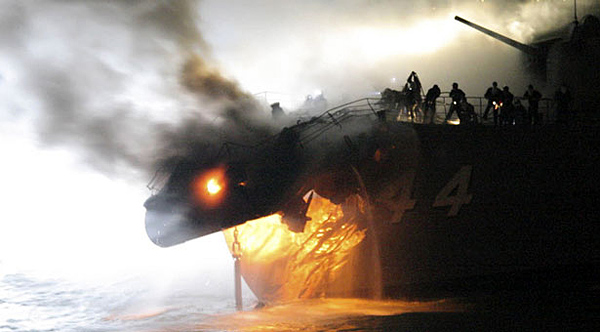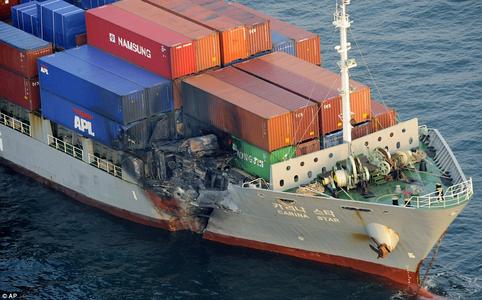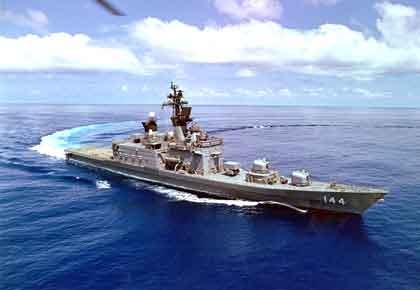October 29, 2009
Bad Day in the Kanmon Straits
JS Kurama, a Japanese Shirane class helicopter destroyer, has collided with a Korean container ship in the narrow Kanmon strait between Kita-Kyushu and Shimonoseki. (H/T: Information Dissemination)
This is why we do those drills. (Pic via)
Comments are disabled.
Post is locked.

This is why we do those drills. (Pic via)
The collision reportedly touched off a fire in the forward paint locker off Kurama which seems to have fared the worse of the two.

I've seen the Kanmon strait. It is very narrow and astonishingly busy. I understand it has very severe tidal currents as well. The total width
of the strait (not the shipping channel) is only 650 meters. The Daily Yomuri reports that around 70 accidents occur in the straits every year. Heads will no doubt roll over this, but it is not obvious that this is the example of flaming incompetence that such an event normally would be.
It is unclear how much of the damage was due to the collision vs the fire, but if paint thinner in sufficient quantity had a steady supply of air then the fire could have easily reached blast furnace temperatures. With the close proximity of the 5 inch magazines and the sheer intensity of the fire, the fact that the ship is pier-side rather than on the bottom is a testament to her damage control team.
.


It is unclear how much of the damage was due to the collision vs the fire, but if paint thinner in sufficient quantity had a steady supply of air then the fire could have easily reached blast furnace temperatures. With the close proximity of the 5 inch magazines and the sheer intensity of the fire, the fact that the ship is pier-side rather than on the bottom is a testament to her damage control team.
.

JS Kurama in happier times
At sea, even in peacetime, things can go south in an instant. There are few more dangerous things than a fire on a ship.
Damage control is vital and this requires DC teams. This brings up a related point that our staffing gurus need to be beat over the head with.
A warship is designed to go into harms way, which generally refers to threats greater than a merchant ship. A warship needs to be able to fight while hurt and have enough crew to do damage control while others are fighting the enemy. The number of personell to do this must take into account those killed by the weapons that caused the damage. Given the difficulties that current staffing policies cause in rather benign conditions, "optimal manning"....isn't.
Damage control is vital and this requires DC teams. This brings up a related point that our staffing gurus need to be beat over the head with.
A warship is designed to go into harms way, which generally refers to threats greater than a merchant ship. A warship needs to be able to fight while hurt and have enough crew to do damage control while others are fighting the enemy. The number of personell to do this must take into account those killed by the weapons that caused the damage. Given the difficulties that current staffing policies cause in rather benign conditions, "optimal manning"....isn't.
Posted by: The Brickmuppet at
07:28 PM
| Comments (1)
| Add Comment
Post contains 363 words, total size 4 kb.
1
I just looked at that in Google Earth, and I can well believe that strait gets interesting tidal currents! Yikes!
I wonder if it might reach the point where they run that thing one-way, switching hourly.
Posted by: Steven Den Beste at Thu Oct 29 21:46:43 2009 (+rSRq)
32kb generated in CPU 0.1035, elapsed 0.2923 seconds.
69 queries taking 0.2808 seconds, 376 records returned.
Powered by Minx 1.1.6c-pink.
69 queries taking 0.2808 seconds, 376 records returned.
Powered by Minx 1.1.6c-pink.









